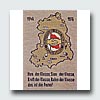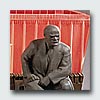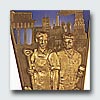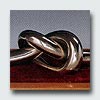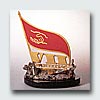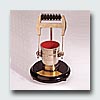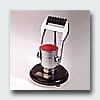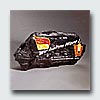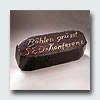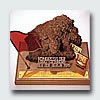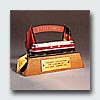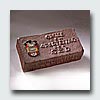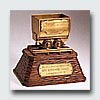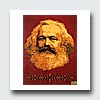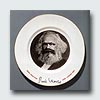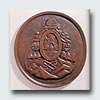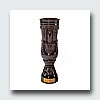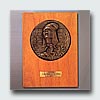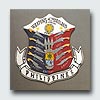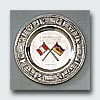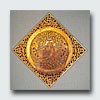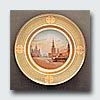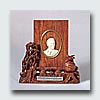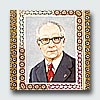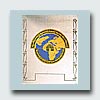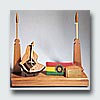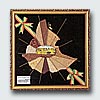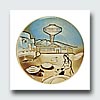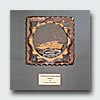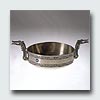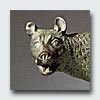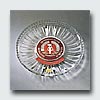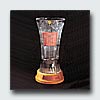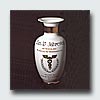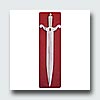|
Gifts to the Party and other
Organizations
by Andreas Michaelis
 The
presentation of gifts and honorifics was of course not invented by socialism;
and the motives for giving have always been on the ambivalent side. It
was only as the relations between Communist and socialist parties and
their organizations and institutions developed that the practice congealed
into a ritual. Just as administrative cadres evolved a principle of anticipatory
obedience, hastening to observe the demands of the upper echelons even
before they were expressed, so too the exchange of gifts developed a logic
and momentum of its own that are not easy to describe. Doubtless there
were no instructions from any central body calling for regular presents
to be made to Party congresses and functionaries; nor is any case known
of action being taken against an institution or organization that had
neglected to mark an event with a visible sign of appreciation. But then,
in the giving of presents, everyone seemed anxious to keep up with the
Joneses. A regional Party organization would not want people saying that
the gift it presented to the congress was less valuable, dignified or
inspired than that given by the neighbouring region. Businesses would
be glad of an opportunity to appear in a good light to local Party authorities,
be it because they had not met the targets set for them by the productivity
plan, be it because they were hoping investment moneys might come their
way. A prevalent anxiety not to disappoint the expectations (no doubt
often imaginary) of the bosses led to a proliferation of presents particularly
between different leadership levels of the SED. No one now can even make
an informed guess at how many thousand gifts must have passed to and fro
in the 44 years that the East German Communist Party existed, nor how
much time, energy and material was used up in the making of those gifts
- or, indeed how many headaches must have been caused the givers who had
to think up suitable presents for their Party superiors. Comrades abroad,
too, had their time cut out dreaming up ever-new presents for the SED
and its leading functionaries. The
presentation of gifts and honorifics was of course not invented by socialism;
and the motives for giving have always been on the ambivalent side. It
was only as the relations between Communist and socialist parties and
their organizations and institutions developed that the practice congealed
into a ritual. Just as administrative cadres evolved a principle of anticipatory
obedience, hastening to observe the demands of the upper echelons even
before they were expressed, so too the exchange of gifts developed a logic
and momentum of its own that are not easy to describe. Doubtless there
were no instructions from any central body calling for regular presents
to be made to Party congresses and functionaries; nor is any case known
of action being taken against an institution or organization that had
neglected to mark an event with a visible sign of appreciation. But then,
in the giving of presents, everyone seemed anxious to keep up with the
Joneses. A regional Party organization would not want people saying that
the gift it presented to the congress was less valuable, dignified or
inspired than that given by the neighbouring region. Businesses would
be glad of an opportunity to appear in a good light to local Party authorities,
be it because they had not met the targets set for them by the productivity
plan, be it because they were hoping investment moneys might come their
way. A prevalent anxiety not to disappoint the expectations (no doubt
often imaginary) of the bosses led to a proliferation of presents particularly
between different leadership levels of the SED. No one now can even make
an informed guess at how many thousand gifts must have passed to and fro
in the 44 years that the East German Communist Party existed, nor how
much time, energy and material was used up in the making of those gifts
- or, indeed how many headaches must have been caused the givers who had
to think up suitable presents for their Party superiors. Comrades abroad,
too, had their time cut out dreaming up ever-new presents for the SED
and its leading functionaries.
 The
oldest item of this kind recalls the union of the two workers' parties,
the Communist KPD and social democratic SPD, in Thuringia. At the congress
held in Gotha to cement that union in March 1946, Wilhelm Pieck was presented
with a cigarette lighter made out of a cartridge case. In the immediate
post-war period, shortage of raw materials often meant that relics of
the war were used in the making of utility objects. The
oldest item of this kind recalls the union of the two workers' parties,
the Communist KPD and social democratic SPD, in Thuringia. At the congress
held in Gotha to cement that union in March 1946, Wilhelm Pieck was presented
with a cigarette lighter made out of a cartridge case. In the immediate
post-war period, shortage of raw materials often meant that relics of
the war were used in the making of utility objects. 
In January and February 1947, an official SED delegation led by Wilhelm
Pieck and Otto Grotewohl paid a first visit to the USSR. Every delegate
was given a statuette of Lenin as a souvenir. The one illustrated here
was in the possession of Max Fechner, and passed to the Museum für
Deutsche Geschichte after his his death in 1973. The model is a copy of
a work by a well-known Soviet artist, Nikolai Andrejeev, who specialized
in figures of Lenin in the 20s.
 When
the Oder-Neisse frontier agreement between the GDR and Poland was signed
on 6 July 1950, it was a major international moment in European post-war
history, and the first international agreement signed by East Germany
as a sovereign state (even if the content was dictated by the strategic
interests of the Soviet Union). A sculptured conversation piece presented
by a Polish youth delegation to the chairman of the German Sports Committee
on the occasion of a peace visit in 1952 preserves the congratulatory
mood of the two countries at that time: the base is inscribed with the
words for peace in various languages - »Frieden, Pokoj, Paix, Peace«. When
the Oder-Neisse frontier agreement between the GDR and Poland was signed
on 6 July 1950, it was a major international moment in European post-war
history, and the first international agreement signed by East Germany
as a sovereign state (even if the content was dictated by the strategic
interests of the Soviet Union). A sculptured conversation piece presented
by a Polish youth delegation to the chairman of the German Sports Committee
on the occasion of a peace visit in 1952 preserves the congratulatory
mood of the two countries at that time: the base is inscribed with the
words for peace in various languages - »Frieden, Pokoj, Paix, Peace«.
Most of the items in this chapter relate to SED Party congresses or visits
to the GDR by Communist Party delegations. As a rule, the SED held a congress
every four or five years. The people of the GDR were sold the event as
the highlight of the social calendar. Every crucial policy decision in
the country's political, economic and cultural evolution was taken at
the congress. Delegates would include top-level officials from combines,
regional authorities, and the Central Committee, and also prominent figures
from the worlds of sports, the arts and science. In addition there were
delegations from well-disposed Communist and socialist parties the whole
world over. The gifts made by foreign visitors were usually mere tokens
of politeness to the hosts; but those exchanged within the GDR's ranks
represented a loaded homage to the »chosen few«.
 The
desktop implements given to Wilhelm Pieck at the 3rd congress by a deputation
from the Ammendorf carriage works represent a distinctive part of East
German history. The factory was one of the major powerhouses of »Transmasch«,
a Soviet joint-stock company. Till the mid-50s it produced machines and
equipment exclusively for the USSR, as part of East Germany's reparations.
It was not until 1954 that the last of the Soviet joint-stock companies
became nationally-owned companies that were permitted to manufacture for
the East German market too. The model of a sleeping car, a faithful replica
of the five hundredth railway carriage built for the USSR, was in Wilhelm
Pieck's study at Niederschönhausen castle till the day he died, and
subsequently entered the Walter Ulbricht collection The
desktop implements given to Wilhelm Pieck at the 3rd congress by a deputation
from the Ammendorf carriage works represent a distinctive part of East
German history. The factory was one of the major powerhouses of »Transmasch«,
a Soviet joint-stock company. Till the mid-50s it produced machines and
equipment exclusively for the USSR, as part of East Germany's reparations.
It was not until 1954 that the last of the Soviet joint-stock companies
became nationally-owned companies that were permitted to manufacture for
the East German market too. The model of a sleeping car, a faithful replica
of the five hundredth railway carriage built for the USSR, was in Wilhelm
Pieck's study at Niederschönhausen castle till the day he died, and
subsequently entered the Walter Ulbricht collection . .
 Comrades
from the Deutzen coal combine swore Everlasting friendship on their
plaque for the 3rd Party congress. The emblems of the SED and the German-Soviet
Friendship Association appear alongside an industrial plant »growing«
out of a coal briquette labelled The Party -vanguard of the working
classes. In the background the sun is rising symbolically. Comrades
from the Deutzen coal combine swore Everlasting friendship on their
plaque for the 3rd Party congress. The emblems of the SED and the German-Soviet
Friendship Association appear alongside an industrial plant »growing«
out of a coal briquette labelled The Party -vanguard of the working
classes. In the background the sun is rising symbolically.
 The
present made by a Magdeburg workman is in a class of its own. The decorative
container made of pegs and cord was sent to Erich Honecker on the occasion
of the 9th Party congress. In a covering letter, the workman thanked the
SED First Secretary for the state's generous support of his large family,
and wished the Party a successful congress. Individual presents of this
kind were few and far between in the 70s and 80s, though. Instead, gifts
were normally industrially made and impersonal - like the piece of an
industrial plant from the Riesa pipe combine. Several copies would be
made so that all the important social occasions in a given period could
be catered for; the present items were given not only to the Riesa Steel
and Rolling Mills Regional Conference but also to the 10th Party congress. The
present made by a Magdeburg workman is in a class of its own. The decorative
container made of pegs and cord was sent to Erich Honecker on the occasion
of the 9th Party congress. In a covering letter, the workman thanked the
SED First Secretary for the state's generous support of his large family,
and wished the Party a successful congress. Individual presents of this
kind were few and far between in the 70s and 80s, though. Instead, gifts
were normally industrially made and impersonal - like the piece of an
industrial plant from the Riesa pipe combine. Several copies would be
made so that all the important social occasions in a given period could
be catered for; the present items were given not only to the Riesa Steel
and Rolling Mills Regional Conference but also to the 10th Party congress.
 Gifts
presented by official delegations from Communist and revolutionary parties
throughout the world frequently featured symbols of the international
labour movement or of socialism established and practised. A classic example
is a gift from the Portuguese Communist Party, where a star with a portrait
of Lenin rises from a hammer and sickle representing Soviet power. Marx's
famous words from the Communist Manifesto, »Workers of the world, unite«,
are emblazoned on a globe, and an inscription on the base avers the undying
friendship of the Portuguese Communist Party and the SED. Gifts
presented by official delegations from Communist and revolutionary parties
throughout the world frequently featured symbols of the international
labour movement or of socialism established and practised. A classic example
is a gift from the Portuguese Communist Party, where a star with a portrait
of Lenin rises from a hammer and sickle representing Soviet power. Marx's
famous words from the Communist Manifesto, »Workers of the world, unite«,
are emblazoned on a globe, and an inscription on the base avers the undying
friendship of the Portuguese Communist Party and the SED.
 A
vase from Bulgaria features a photomontage by John Heartfield which originally
appeared on the cover of a Communist paper in November 1933. It shows
an outsize Georgi Mikhailovich Dimitroff striking a victorious pose before
his accuser, Hermann Göring, in the Reichstag fire trial. The scene
symbolizes the triumph of Communism over Fascism: in 1933 Dimitroff, a
Bulgarian politician and co-founder of that country's Communist Party,
was in fact acquitted of any involvement in the Reichstag fire. A
vase from Bulgaria features a photomontage by John Heartfield which originally
appeared on the cover of a Communist paper in November 1933. It shows
an outsize Georgi Mikhailovich Dimitroff striking a victorious pose before
his accuser, Hermann Göring, in the Reichstag fire trial. The scene
symbolizes the triumph of Communism over Fascism: in 1933 Dimitroff, a
Bulgarian politician and co-founder of that country's Communist Party,
was in fact acquitted of any involvement in the Reichstag fire.
The ancestral gallery of the Communist movement appears in eloquent style
on a wall platter from Laos depicting Marx and Lenin triumphantly proclaiming
their ideas to that country.
A collage representing the plenty of agriculture in Ethiopia inevitably
strikes us now with a bitter irony, given the starvation that folowed
Mengistu Haile Mariam's socialist experiment. Further
items are from Israel, Chile, and the Democratic Front for Liberation
of Palestine, the leader of which, Nawef Hawatmeh, visited the GDR in
1980 at the invitation of the SED. Further
items are from Israel, Chile, and the Democratic Front for Liberation
of Palestine, the leader of which, Nawef Hawatmeh, visited the GDR in
1980 at the invitation of the SED.
 For
a short period in the 70s, East Germany had close relations with Somalia.
Mohammed Siyaad Barre, head For
a short period in the 70s, East Germany had close relations with Somalia.
Mohammed Siyaad Barre, head  of
state and of the Party, conveyed the fraternal greetings of the Somali
Socialist Party to Erich Honecker and the SED in the form of two elephant
teeth and a table decoration incorporating the arms of Somalia. Before
long, however, the GDR found itself in a dilemma similar to that of their
relations with the Sudan. In 1977 a bloody war broke out between the socialist
brothers Somalia and Ethiopia; the GDR took the side of Ethiopia, and
its former comrade Siyaad Barre was revealed overnight as a dictator and
an imperialist lackey. of
state and of the Party, conveyed the fraternal greetings of the Somali
Socialist Party to Erich Honecker and the SED in the form of two elephant
teeth and a table decoration incorporating the arms of Somalia. Before
long, however, the GDR found itself in a dilemma similar to that of their
relations with the Sudan. In 1977 a bloody war broke out between the socialist
brothers Somalia and Ethiopia; the GDR took the side of Ethiopia, and
its former comrade Siyaad Barre was revealed overnight as a dictator and
an imperialist lackey.
 SED
deputations regularly attended the Party congresses of Communist parties
elsewhere. First Secretary Honecker visited all the Soviet Union's Party
congresses held during his term in office personally. These occasions
were seen (at least by the GDR) as being of major significance, and pointing
the way ahead for the Communist movement as a whole. From them, the SED
delegates routinely returned with souvenirs. Workers in the Chelyabinsk
area presented the SED deputation with a composition incorporating various
widely used Communist symbols. Marxist-Lenist theory, symbolized by the
works of Marx, Engels and Lenin, is represented on a red star. Above it
is the globe, with the Soviet Union highlighted, and a banner bearing
the words, Workers of the world, unite!. SED
deputations regularly attended the Party congresses of Communist parties
elsewhere. First Secretary Honecker visited all the Soviet Union's Party
congresses held during his term in office personally. These occasions
were seen (at least by the GDR) as being of major significance, and pointing
the way ahead for the Communist movement as a whole. From them, the SED
delegates routinely returned with souvenirs. Workers in the Chelyabinsk
area presented the SED deputation with a composition incorporating various
widely used Communist symbols. Marxist-Lenist theory, symbolized by the
works of Marx, Engels and Lenin, is represented on a red star. Above it
is the globe, with the Soviet Union highlighted, and a banner bearing
the words, Workers of the world, unite!.
 But
the non plus ultra of political symbolism in our collection must
surely be a sculpture given to the SED delegation at the 3rd congress
of the Cuban Communist Party. The evils of the world - symbolized by a
smashed swastika, a scattering of skulls, two nuclear missiles, a chain,
and a bird of prey that stands for United States imperialism - are vanquished
by a Picasso peace dove. That dove, first seen 1949 at a peace congress
in Paris, became the emblem of the international peace movement; but in
socialist countries it was also used as a symbol of the struggle against
imperialism. But
the non plus ultra of political symbolism in our collection must
surely be a sculpture given to the SED delegation at the 3rd congress
of the Cuban Communist Party. The evils of the world - symbolized by a
smashed swastika, a scattering of skulls, two nuclear missiles, a chain,
and a bird of prey that stands for United States imperialism - are vanquished
by a Picasso peace dove. That dove, first seen 1949 at a peace congress
in Paris, became the emblem of the international peace movement; but in
socialist countries it was also used as a symbol of the struggle against
imperialism.
Further gifts were made to the Party or its leadership on the anniversaries of the Party's establishment; to mark special events organized
or attended by the Party; or to mark the jubilees and other special occasions
of nations, Parties and organizations elsewhere. Even sports clubs sometimes
felt obliged to pay personal homage to Honecker; after all, it was an
open secret among soccer fans that Dynamo Berlin's success in taking the
championship ten times in a row owed something to the wish - and protection
- of the very highest echelons, and assistance of that order called for
tribute in recognition. Every year, the players and officials of Dynamo
Berlin complimented their »highly esteemed comrade Erich Honecker« with
some gift or other.
anniversaries of the Party's establishment; to mark special events organized
or attended by the Party; or to mark the jubilees and other special occasions
of nations, Parties and organizations elsewhere. Even sports clubs sometimes
felt obliged to pay personal homage to Honecker; after all, it was an
open secret among soccer fans that Dynamo Berlin's success in taking the
championship ten times in a row owed something to the wish - and protection
- of the very highest echelons, and assistance of that order called for
tribute in recognition. Every year, the players and officials of Dynamo
Berlin complimented their »highly esteemed comrade Erich Honecker« with
some gift or other.
 The
Ministry of State Security (the Stasi ministry) was one of the GDR's institutions
that received the most gifts. Everyone - SED regional officers, industrial
organizations, state and social organizations, other security services
in the GDR, as well as similar services in socialist foreign countries
- felt obliged to mark the anniversary of the establishment of the ministry
every year. The
Ministry of State Security (the Stasi ministry) was one of the GDR's institutions
that received the most gifts. Everyone - SED regional officers, industrial
organizations, state and social organizations, other security services
in the GDR, as well as similar services in socialist foreign countries
- felt obliged to mark the anniversary of the establishment of the ministry
every year.
In the early 70s, when the Unidad Popular regime was in power there, East
Germany enjoyed particularly close ties with Chile.  Hopes
that the South American country would join Cuba as a second stable partner
for the GDR's political, economic and cultural interests in Latin America
were of course brought to nothing by the military coup of September 1973
and the murder of Marxist President Salvador Allende. The SED continued
its relations with parties sympathetic to Communism, however; and thousands
of Chilean émigrés went into East German exile during the
Pinochet dictatorship. The portrait photograph of Allende was a gift from
his widow, who visited the GDR in September 1974. Her handwritten dedication
thanks East Germany for its solidarity. Hopes
that the South American country would join Cuba as a second stable partner
for the GDR's political, economic and cultural interests in Latin America
were of course brought to nothing by the military coup of September 1973
and the murder of Marxist President Salvador Allende. The SED continued
its relations with parties sympathetic to Communism, however; and thousands
of Chilean émigrés went into East German exile during the
Pinochet dictatorship. The portrait photograph of Allende was a gift from
his widow, who visited the GDR in September 1974. Her handwritten dedication
thanks East Germany for its solidarity.
For one former East German, the ties which were established in those days
with Chile's Communists and socialists have of course paid off: Erich
Honecker spent his unanticipated retirement in Chilean exile.
|
